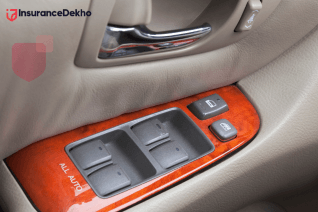Power Windows: Features, Pros & Cons, and How They Work
Power windows, also known as electric windows, are a standard feature in most modern cars. They allow passengers to raise or lower the window glass with the push of a button, replacing the traditional manual crank system. Powered by small electric motors, these windows are controlled through switches placed on the driver’s side and individual passenger doors.
Read on to know about Power windows’ features with pros and cons!

Key Highlights
-
Convenient Operation: Power windows allow one-touch opening and closing, improving ease of use for drivers and passengers.
-
Modern Features: Some vehicles offer remote window control via key fobs or apps, plus post-ignition operation timers.
-
Common Issues: Failures may occur due to motor burnout, regulator misalignment, or faulty switches, often needing costly repairs.
-
Conversion & Cost: Manual windows can be upgraded to power windows via aftermarket kits, but this may void manufacturer warranties.
What is a Power Window in a Car?
Initially introduced as a luxury add-on in premium vehicles, power windows have become a basic feature in most vehicles, including budget-friendly models. They not only offer added comfort and convenience, but also enhance vehicle safety and design aesthetics. Today, power windows are seen as a necessity, not just a premium feature.
5 Top Features of Power Windows
Power windows come with several advanced features that make them more efficient, user-friendly, and safe. Modern power windows include a range of features designed for better control, safety, and convenience.
One-Touch Up/Down Function
-
Enables the window to fully open or close with a single press of the switch.
-
Useful when driving, as it allows quick adjustments without distraction.
Courtesy Power-On
-
Allows windows to operate for a few seconds even after turning off the ignition.
-
Helpful for passengers who need to adjust windows before exiting.
Anti-Pinch Safety Sensors
-
Detects obstructions (like a child’s hand or an object) during closing.
-
Automatically reverses the window direction to prevent injury.
Remote Control Operation
-
In some high-end vehicles, windows can be operated remotely using a key fob or a mobile app.
-
Useful for ventilating the car before entry, especially in hot weather.
Timer-Based Cutoff
-
Delays window system shutdown after ignition is turned off.
-
Offers extra flexibility and ease of use for a short duration post-engine stop.
How Do Power Windows Work?
Power windows in vehicles function through energies distributed among electrical and mechanical elements.
Components Involved: Switches, Motors, Regulators
-
Power window controls, known as switches, exist on the exterior surface of vehicle doors.
-
Small electric motors powered by electricity move the vehicle windows through their operational range.
-
The window glass control mechanism consists of regulators, which function as mechanical components for movement control.
Electrical Mechanism and Power Distribution
A switch-activated signal delivers electricity to the motor, thus making the window regulator function. The glass ascends or descends because the motor activates gear-based mechanisms connected to several arms. The vehicle draws battery power to operate its power window system because it depends on the entire electrical system.
-
The Driver’s Control Panel includes an individual control for each window to operate the glass manually.
-
From inside the driver's door, there exists a master control panel that enables the operation of all vehicle windows yet passengers have their switches for their respective windows.
Pros of Power Windows
Customers benefit from power windows because these systems surpass manual windows in many ways.
-
Enhanced Convenience and Ease of Use
Users can operate power windows without physical strain because this system features a button instead of manual cranking. Driving passengers can take advantage of the benefit provided by automated window control.
-
Improved Safety Features
Child safety locks serve as protective features that stop accidental operation of windows to prevent children from unbeknownst control of their windows.
Automatic sensors prevent injuries through the automatic detection of approaching objects while windows are closing.
-
Accessibility for Individuals with Physical Challenges
The automated window system makes driving accessible for people who require assistance when operating vehicle windows.
-
Modern Aesthetics and Added Vehicle Value
Power windows enhance both the vehicle’s market value through modern appearance and become a leading preference among potential buyers.
Cons of Power Windows
The advantages of power windows are mixed with several disadvantages.
-
Potential for Malfunction (Motor or Regulator Failure)
Destruction of power window components through normal wearing creates problems that inconvenience users. Common issues include:
-
Motor burnout
-
Switch failure
-
Regulator misalignment
-
Higher Repair and Replacement Costs
The cost of fixing power window components remains high for luxury car models because of the high pricing of these components.
-
Dependence on the Vehicle’s Electrical System
Electrical power is essential for power windows, so they stop working when the battery runs out or encounters electrical system failures.
-
Risk of Battery Drain with Excessive Use
The continued operation of power windows leads to battery power reduction, especially in vehicles with older models, when the engine is shut off.
-
Maintenance and Repair Considerations
Power windows need regular maintenance checks to prevent premature system failures along with unexpected operation breakdowns.
Common Issues and Repair Cost
A window that remains stuck in the open position usually indicates a broken motor or a jammed window regulator. If the window moves slowly, it could be due to accumulated dirt in the window tracks, which causes friction, or it might be a sign of a weakening motor. When there is no response at all after pressing the switch, the issue is likely related to a faulty switch or a defect in the electrical wiring.
In terms of repair costs in India, replacing a power window motor typically ranges between Rs. 3,000 and Rs. 10,000, depending on the vehicle model. Fixing or replacing a window regulator usually costs between Rs. 2,000 and Rs. 7,000, while a switch replacement may cost around Rs. 1,000 to Rs. 3,000.
Vehicle owners can acquire aftermarket power window installation systems for manual windows at a range between Rs. 5,000 and Rs. 15,000 per door unit based on the quality and manufacturer choices. A warranty may get canceled when aftermarket power windows are installed into a car.
Power windows have changed the way people enjoy vehicle comfort because they enable effortless window regulation through automated systems. Such power window features as automatic operation alongside safety sensors and remote control capability improve both driving comfort and vehicle exterior appeal.
The installation of power windows requires proper maintenance as they depend on the car’s electrical system, yet carrying out necessary upkeep helps preserve their functionality. Provoked maintenance work and safe operation methods, and prompt service interventions will help power windows perform efficiently for multiple years.














































